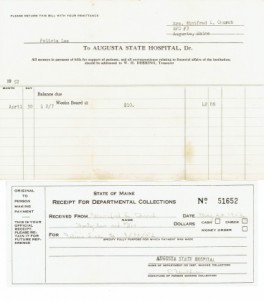In his 1930 novel Immaturity, George Bernard Shaw wrote, “If you cannot get rid of the family skeleton, you may as well make it dance.” Shaw had a point with that statement. While we can deny them, hide them, or ignore them, we can’t remove the family skeletons from their places in our family trees. Once they’re “out of the closet,” those dry bones will walk around; what we make of them is up to us.
Scott C. Steward’s recent reposting of his article Genealogical Complexities brought to my mind the dilemma of all family history: how much do we really want to know, and what responsibility do we have in dispensing that information? Whoever said “You can never know whether you want to know until you already do” must have found a really tall skeleton in the family history closet. Perhaps after some reflection, the wisdom of that sentence arrives couched in terms of “How do I tell the family?” Currently, finding mental illness in the family tree still seems to be considered a skeleton, but convicted seventeenth-century witches are something of a perk. And royalty, however nefarious, infamous, or criminal, is status. Are we then to accept that one man’s trash is another’s treasure, and one researcher’s skeleton is another’s proud prize?
In my own experience, most members of my family are interested and willing to hear and accept my research findings (and encourage my efforts to write about them, however much their eyes glaze over), but there is still some discomfort concerning certain issues. For instance, one very elderly paternal cousin had been corresponding with my mother before her death, correspondence I later continued. This cousin asked me to share all my research information on her family’s branch for her daughter’s benefit. Obligingly, I sent everything she asked for, including public record documentation as well as “the tree.”
Months had passed without any response when finally her letter arrived describing how upset she was at the news that her maternal grandmother did not in fact die young, as her parents had insisted, but had died in 1952 at age 97. The records describing the woman’s unfortunate decades-long institutionalization, divorce, and death were less upsetting to this cousin than the death record itself. Mental illness for her generation was a stigma to be hidden, concealed, and never discussed. While this cousin “wanted to know,” clearly she wasn’t prepared for the truth contained in that bit of family research. Unaware, unwitting, and unsuspecting, I had danced a skeleton out of her closet to her anguish.
The accused (but not convicted) Salem witches in my family are balanced by several ordained Baptist ministers . . . who are preceded by packs of Puritans . . . who are subsequently lightened by a purported relationship to the original Mother Goose . . . whose presence in my family tree is offset by an excommunicated farmer and a psychic-medium great-grandmother accompanied by her spirit guide. Sometimes our closet skeletons can be lots of fun if we remember to be as aware of the living family’s feelings as we are of the research involved.
However, not all skeletons are persons. Many people, fascinated when I tell them that an autopsy had been performed on a table in my kitchen in 1803, automatically look warily at my 1980s-era kitchen table as though it would sprout a body. Seating them for dinner thereafter is always a fun dance, something like musical chairs!
While my family tree has no “seriously skeletonized” persons (in my opinion), I love those I do have. The stories of those ancestors make a fine quadrille and provide the stories which make them better-rounded personalities. None of my ancestors’ actions and behaviors, good or bad, make me who I am, be they traitors or witches, delusional or boring. They create no obligation for action or regret, but provide me with so much fodder for stories, and their DNA gives me permission to blame them for the annoying physical attribute of the day. But be aware that tomorrow’s skeletons are today’s black sheep, stripped of all but their closets. We might as well make the skeletons dance to our piping, and put them in historical perspective. So, Mr. Shaw, would you care for a minuet, a polka, or a few bars of “The Stripper?”
Share this:

About Jan Doerr
Jan Doerr received a B.A. degree in Sociology/Secondary Education from the University of New Hampshire, and spent a long career in the legal profession while researching her family history. She has recently written and published articles for WBUR.org’s Cognoscenti blog: “Labor of Love: Preserving a 226-Year-Old Family Home and Preparing to Let It Go” and “The Value of Family Heirlooms in a Digital Age.” Jan currently lives with her attorney husband in Augusta, Maine, where she serves two Siamese cats and spends all her retirement money propping up a really old house.View all posts by Jan Doerr →
